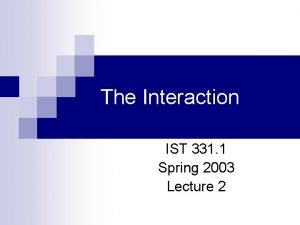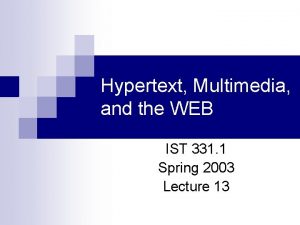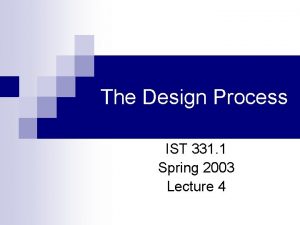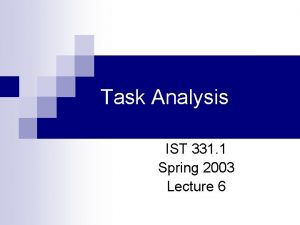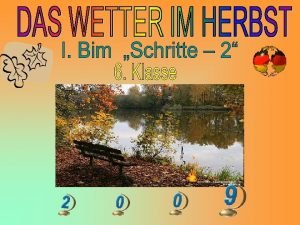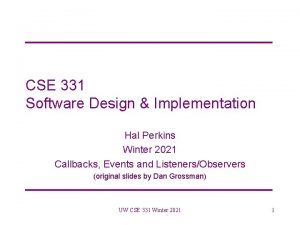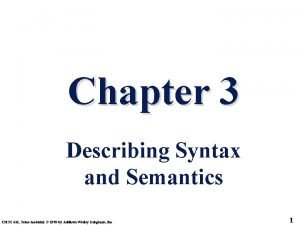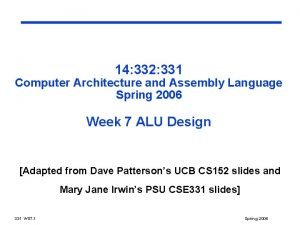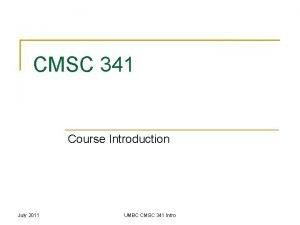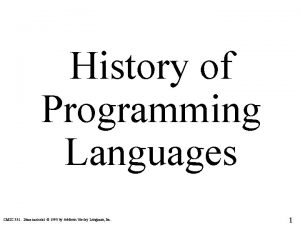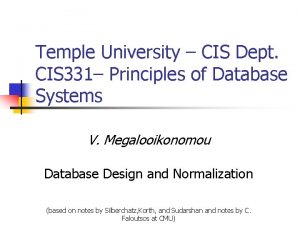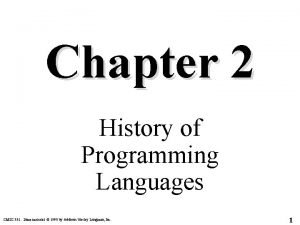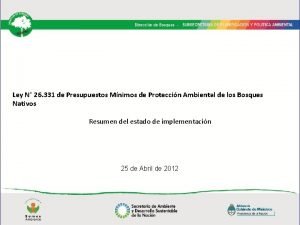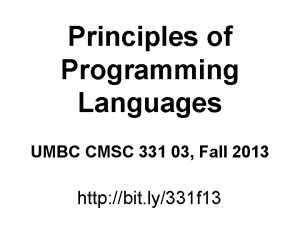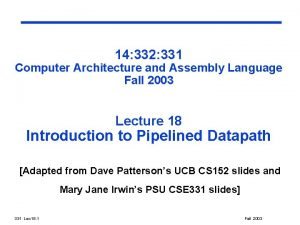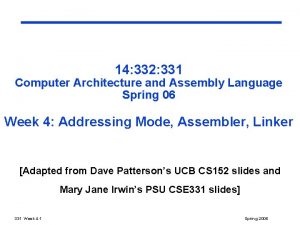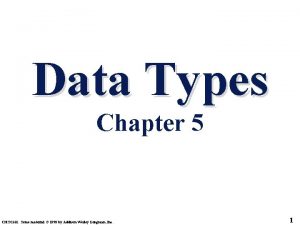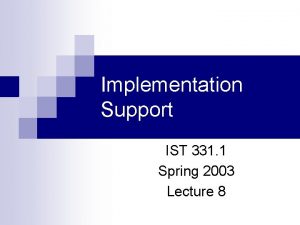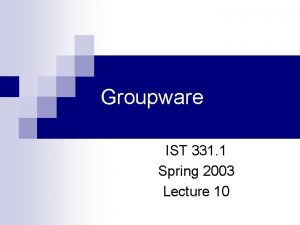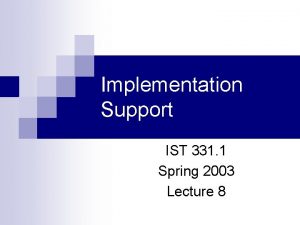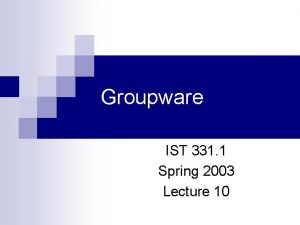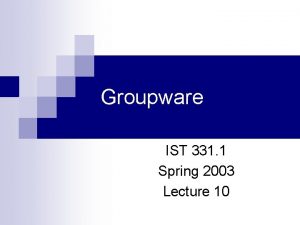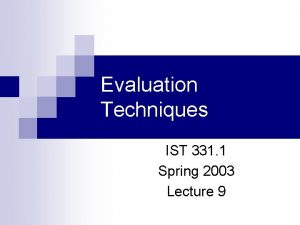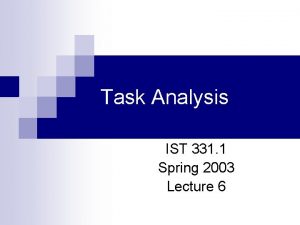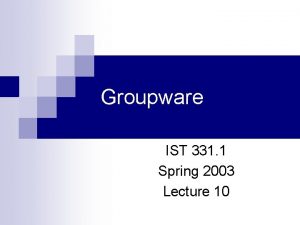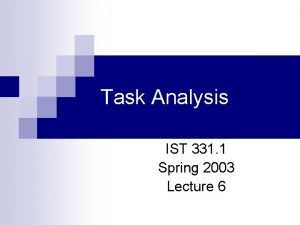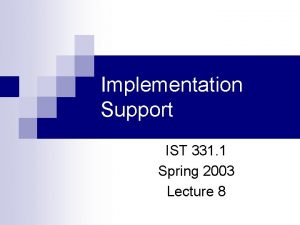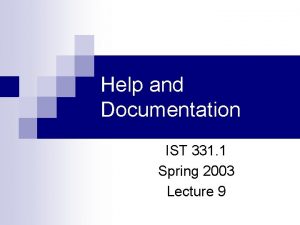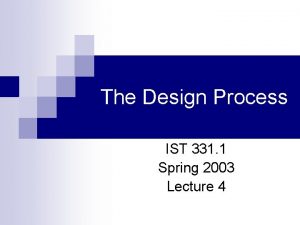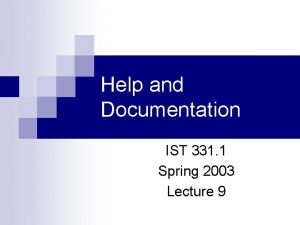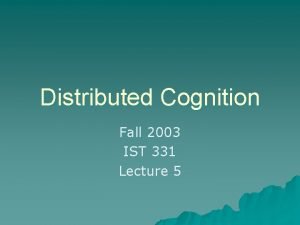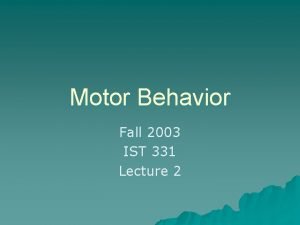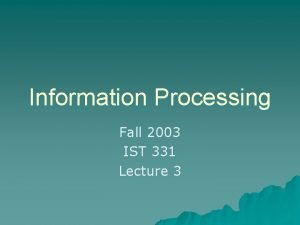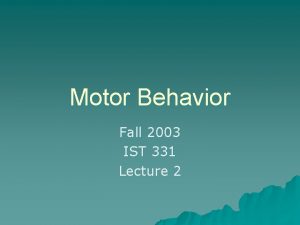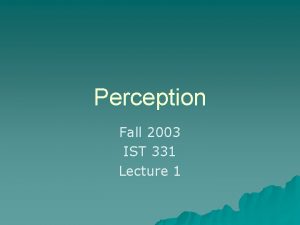The Interaction IST 331 1 Spring 2003 Lecture



























- Slides: 27

The Interaction IST 331. 1 Spring 2003 Lecture 2

Interaction Frameworks Interaction: communication between the user and the system

Terms User wants to accomplish goals n Domain of an application n Tasks are operations to manipulate the concepts of a domain n An intention is a specific action required to meet the goal n Task Analysis n

Execution-Evaluation Cycle Donald Norman’s Interaction framework – execution & evaluation phases • user establishes the goal • formulates intention • specifies actions at interface • executes action • perceives system state • interprets system state • evaluates system state with respect to goal Norman’s model concentrates on user’s view of the interface

Execution-Evaluation Cycle Some systems are harder to use than others Gulf of Execution user’s formulation of actions allowed by the system Gulf of Evaluation user’s expectation of changed system state actual presentation of this state Focus is on user’s view of the interaction

Interaction Framework extended by Abowd and Beale: their interaction framework has 4 parts • user • input • system • output presentation core performance each has its own unique language interaction translation between languages problems in interaction = problems in translation observation task articulation

Interaction Framework user intentions translated into actions at the interface translated into alterations of system state reflected in the output display interpreted by the user general framework for understanding interaction • not restricted to electronic computer systems • identifies all major components involved in interaction • allows comparative assessment of systems • an abstraction

Ergonomics Study of the physical characteristics of interaction Also known as human factors. Ergonomics good at defining standards and guidelines for constraining the way we design certain aspects of systems.

Ergonomics - examples • arrangement of controls and displays e. g. controls grouped according to function or frequency of use, or sequentially • surrounding environment e. g. seating arrangements adaptable to cope with all sizes of user • health issues e. g. physical position, lighting, noise, environmental conditions (temperature, humidity) • use of color e. g. use of red for warning, green for okay, awareness of color-blindness etc.

Interaction styles Interaction: dialogue between computer and user Some applications have very distinct styles of interaction. We can identify some common styles • command line interface • menus • natural language • question/answer and query dialogue • form-fills and spreadsheets • WIMP

Command line interface Way of expressing instructions to the computer directly. function keys, single characters, short abbreviations, whole words, or a combination • suitable for repetitive tasks • better for expert users than novices • offers direct access to system functionality • command names/abbreviations should be meaningful Typical example: the Unix system

Menus Set of options displayed on the screen Options visible – less recall - easier to use – rely on recognition so names should be meaningful Selected by using mouse, numeric or alphabetic keys Often options hierarchically grouped: sensible grouping is needed Menu systems can be • purely text based, with options presented as numbered choices • graphical selected by arrow keys • graphical selected by mouse • combination (e. g. mouse plus accelerators) Restricted form of full WIMP system

Natural language Familiar to user Use speech recognition or typed natural language Problems • vague • ambiguous • hard to do well! Solutions • try to understand a subset • pick key words

Query interfaces Question/answer interfaces • user led through interaction via series of questions • suitable for novice users but restricted functionality • often used in information systems Query languages (e. g. SQL) • used to retrieve information from database • requires understanding of database structure and language syntax, hence requires some expertise

Form-fills Primarily for data entry or data retrieval Screen like paper form. Data put in relevant place. Requires • good design • obvious correction facilities

WIMP Interface • Windows • Icons • Menus • Pointers (or windows, icons, mice, and pull-down menus) default style for majority of interactive computer systems, especially PCs and desktop machines

Windows Areas of the screen that behave as if they were independent terminals • can contain text or graphics • can be moved or resized • can overlap and obscure each other, or can be laid out next to one another (tiled) • scrollbars allow the user to move the contents of the window up and down or from side to side • title bars describe the name of the window

Icons • small picture or image • represents some object in the interface often a window or action • windows can be closed down (iconified) small representation many accessible windows • icons can be many and various highly stylized or realistic representations.

Pointers • important component WIMP style relies on pointing and selecting things • usually achieved with mouse • also joystick, trackball, cursor keys or keyboard shortcuts • wide variety of graphical images

Menus Choice of operations or services offered on the screen. Required option selected with pointer • problem - menus can take up a lot of screen space • solution - menu appears when needed

Kinds of Menus Menu Bar at top of screen (normally), menu drags down • pull-down menu - mouse hold and drag down menu • drop-down menu - mouse click reveals menu • fall-down menus - mouse just moves over bar! Contextual menu appears where you are • pop-up menus - actions for selected object • pie menus - arranged in a circle - easier to select item (larger target area) - quicker (same distance to any option) … but not widely used!

Menus extras Cascading menus • hierarchical menu structure • menu selection opens new menu • and so in ad infinitum Keyboard accelerators • key combinations - same effect as menu item • two kinds - active when menu open - usually first letter - active when menu closed - usually Ctrl + letter - usually different !!!

Menus design issues • which kind to use • what to include in menus at all • words to use (action or description) • how to group items • choice of keyboard accelerators

WIMP look and feel Lots of things you can interact with: • main WIMP components (windows, menus, icons) • buttons • dialogue boxes • palettes Collectively known as widgets appearance + behavior = look and feel

Buttons individual and isolated regions within a display that can be selected to invoke an action. Special kinds • radio buttons - set of mutually exclusive choices • check boxes - set of non-exclusive choices

dialogue boxes information windows that pop up to inform of an important event or request information. e. g: when saving a file, a dialogue box is displayed to allow the user to specify the filename and location. Once the file is saved, the box disappears.

Social and Organizational Context Interaction affected by social and organizational context • other people - desire to impress, competition, fear of failure • motivation - fear, allegiance, ambition, self-satisfaction • inadequate systems - cause frustration and lack of motivation
 Spring, summer, fall, winter... and spring cast
Spring, summer, fall, winter... and spring cast Ist 331
Ist 331 Ist 331
Ist 331 Ist 331
Ist 331 01:640:244 lecture notes - lecture 15: plat, idah, farad
01:640:244 lecture notes - lecture 15: plat, idah, farad Autumn is yellow winter is white
Autumn is yellow winter is white Analysisist
Analysisist Heute mittwoch guten morgen mittwoch winter
Heute mittwoch guten morgen mittwoch winter Zu glauben ist schwer. nichts zu glauben ist unmöglich
Zu glauben ist schwer. nichts zu glauben ist unmöglich Winter kommt winter kommt flocken fallen nieder
Winter kommt winter kommt flocken fallen nieder Ich habe heute klassendienst
Ich habe heute klassendienst Es ist herbst es ist herbst bunter blätter fliegen
Es ist herbst es ist herbst bunter blätter fliegen Uw cse 331
Uw cse 331 Anth 331
Anth 331 Cmsc 331
Cmsc 331 14:332:331
14:332:331 Umbc cmsc 341
Umbc cmsc 341 Pred-331
Pred-331 Cmsc 331
Cmsc 331 14:332:331
14:332:331 Cis 331
Cis 331 Cmsc 331
Cmsc 331 Ley 26 331
Ley 26 331 Umbc cmsc 331
Umbc cmsc 331 14:332:331
14:332:331 Ce 331
Ce 331 14:332:331
14:332:331 Cmsc 331
Cmsc 331

